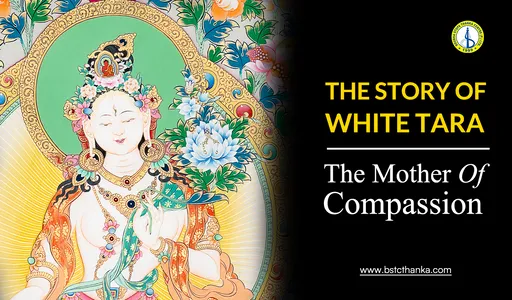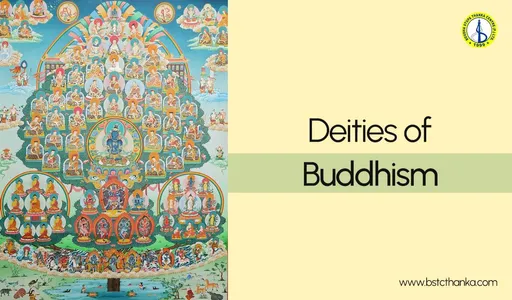
Manjushree - The Bodhisattva of Wisdom
Manjushri (Manjushree) The Bodhisattva of Wisdom
Among the radiant pantheon of Buddhist deities, Manjushri represents the top (pinnacle) of intellectual and spiritual understanding, wielding the sword of discernment to cut through the blindness of ignorance and illuminate the path to enlightenment. This Bodhisattva, a compassionate being who delays enlightenment to guide others, makes use of her powerful intellect to illuminate the path for practitioners seeking liberation.
Manjushri's Form and Symbolism
Manjushri (Manjushree) is typically depicted as a youthful figure, symbolizing the fresh and vibrant nature of wisdom. He often sits regally in a lotus posture, signifying the blossoming of enlightenment through the cultivation of wisdom.
The imagery surrounding Manjushri is rich with symbolism, with each element carrying profound meaning. The sword he holds represents the power to sever ignorance and illusion, enabling beings to see reality as it truly is. This sword is not one of violence but of clarity and understanding, guiding practitioners on the path to enlightenment. Often, he is depicted riding a majestic blue lion, symbolizing the wild power of wisdom that can conquer any obstacle.
The lotus flower, a universal symbol in Buddhism, signifies purity and the potential for enlightenment. By resting the Prajnaparamita Sutra upon the lotus, Manjushri emphasizes the inseparability of wisdom and enlightenment, teaching that true awakening arises from the cultivation of insight and understanding.
Manjushri embodies more than just intellectual knowledge. He represents a multifaceted wisdom that encompasses:
• Prajna (discerning wisdom): the ability to see through illusion and comprehend reality.
• Upāya (Skilful Means): The wisdom to employ different methods to suit the needs of each student.
• Samadhi (meditation): the focused concentration that allows for deep insight and understanding.
By contemplating Manjushri's qualities, practitioners cultivate these aspects of wisdom within themselves.
Manjushri in Buddhist Traditions
Manjushri is a prominent figure in Mahayana and Vajrayana Buddhism. In Tibetan Buddhism, he is revered as one of the Eight Manifestations of Guru Padmasambhava, the founder of Tibetan Buddhism. Manjushri is also the patron saint of learning and scholarship, and universities and educational institutions throughout Asia often feature his statues or paintings.
Cultivating Wisdom in Our Lives
Manjushri's message is relevant beyond the monastery walls. In our daily lives, we can all benefit from cultivating wisdom. Here are some ways to connect with Manjushri's energy:
• Meditation: Regular meditation practice sharpens the mind and fosters clarity of thought.
• Learning: Continuously seeking knowledge and new perspectives broadens our understanding.
• Compassionate Action: Applying wisdom with compassion allows us to navigate challenges with understanding and kindness.
Teachings and Practices
As the Bodhisattva of Wisdom, Manjushri plays a crucial role in guiding practitioners along the path to enlightenment. His teachings emphasize the importance of cultivating wisdom alongside compassion, recognizing that true insight arises from a heart imbued with kindness and empathy.
Devotees often invoke Manjushri's presence through meditation and prayer, seeking his guidance in overcoming obstacles on the spiritual journey. Practices dedicated to Manjushri may involve the recitation of his mantra, "Om A Ra Pa Ca Na Dhih," or the visualization of his form as a means of deepening one's connection to wisdom and insight.
Manjushri across cultures
While Manjushri holds a central place in Mahayana Buddhism, his influence extends beyond traditional Buddhist circles. Across East Asia, he is venerated as a symbol of scholarly pursuit and intellectual prowess, revered by students and scholars alike for his ability to dispel ignorance and foster wisdom.
In art, literature, and religious practice, Manjushri continues to inspire devotees to embark on the noble quest for wisdom and enlightenment. Whether depicted in intricate sculptures adorning temple walls or invoked in silent contemplation, his presence serves as a reminder of the boundless potential of the human mind to awaken to the true nature of reality.
According to history, the Kathmandu Valley was once a vast lake named Nagdaha. Manjushri, the Bodhisattva of wisdom, wielded his flaming sword to cleave open the southern rim of the valley at Chobar Dada, allowing the waters to drain and creating the fertile land we know today. This act of compassion not only made the valley habitable but also released the valley dwellers trapped beneath the lake. Manjushri's legendary feat is credited with shaping the Kathmandu Valley's unique geography and paving the way for civilization to flourish.
Frequently Asked Questions About Manjushi
Who is Manjushri?
Manjushri is a revered Bodhisattva in Mahayana Buddhism, particularly prominent in Tibetan Buddhism. He embodies wisdom, insight, and knowledge. Often depicted holding a flaming sword and a book, he represents the power of wisdom to cut through ignorance and illuminate the path to enlightenment.
What is Manjushri known for?
Manjushri/Manjushree is famous for the legendary feat of splitting the Chobar Dada hill in Nepal, allowing the waters of a vast lake to drain, and creating the Kathmandu Valley. This act is seen as a symbol of bringing wisdom and knowledge to dispel darkness and make way for growth and enlightenment.
What are Manjushri's symbols?
• Flaming Sword: represents the power of wisdom to cut through illusion and ignorance.
• Book: symbolizes knowledge, teachings, and the path to enlightenment.
• Lotus Flower: represents purity, awakening, and spiritual growth.
What are the benefits of worshipping Manjushri?
Devotees seek Manjushri's blessings for:
• Increased wisdom and knowledge
• Improved memory and concentration
• Success in education and learning pursuits
• Clarity of thought and decision-making
• Overcoming confusion and ignorance
How is Manjushri worshipped in Buddhism?
Practices associated with Manjushri include:
• Mantras: Chanting specific mantras dedicated to Manjushri.
• Offerings: making offerings of flowers, incense, or knowledge texts.
• Visualizations: meditating while visualizing Manjushri and his blessings.
• Reciting Texts: reading scriptures or prayers associated with Manjushri.
Is Manjushri a historical figure?
Manjushri/Manjushree is considered a historical figure, and he is a symbolic representation of the qualities of wisdom and knowledge essential on the path to enlightenment in the traditional sense.
What is Manjushri's significance in Nepal?
The legend of Manjushri creating the Kathmandu Valley is deeply ingrained in Nepali culture and history. He is considered a guardian deity of Nepal, and many temples and stupas are dedicated to him.





